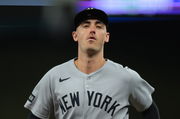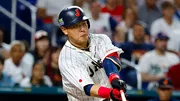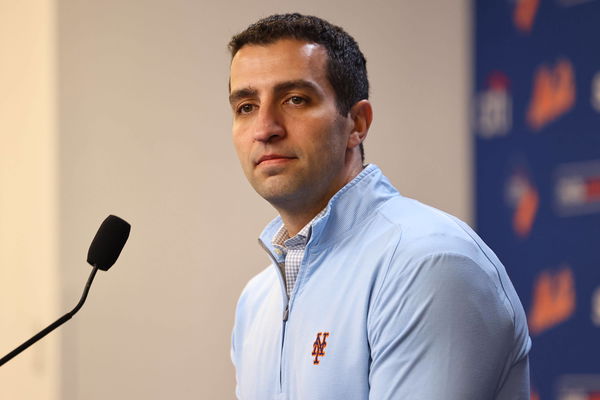
Imago
Source: Imago

Imago
Source: Imago
There was a time when the New York Yankees thrived on chaos—now, it feels like chaos is the plan. Aaron Judge can only carry so much before the cracks become craters, and the scoreboard starts looking like a warning sign. The Bronx Bombers still sell the image of dominance, but peel back the pinstripes, and the blueprint looks suspiciously like a coin toss.
Watch What’s Trending Now!
Meanwhile, the New York Mets and Boston Red Sox are finding new ways to test the limits of patience—both their own and their fans’. Steve Cohen’s empire of calm and Alex Cora’s dugout bravado offer contrasting philosophies, but the results whisper the same uncomfortable truth. Big payrolls, big markets, big dreams—yet somehow, the GPS still recalculates to “rebuilding phase.”
ADVERTISEMENT
Yankees might not make the postseason
The Yankees’ October chances have eroded visibly, and their postseason probability has just slid to 80.7 percent. Models that once perched them above ninety percent now show mid-to-high seventies or even lower. A brutal midseason collapse has whittled cushion into crisis, turning optimism into anxious urgency among fans. Baseball-Reference, FanGraphs, and betting markets all reflect the fall, albeit with slightly differing percentages reported. That statistical retreat frames everything else: roster stress, managerial scrutiny, and front office accountability conversations now.
On the field, poor execution explains losses; behind the scenes, managerial choices deepen the malaise significantly. Aaron Boone’s tactical gambles and inconsistent bullpen usage have invited relentless second-guessing from fans and analysts. General manager inaction magnifies problems, leaving roster holes glaring at the most inconvenient, season-defining moments. The Yankees’ front office has been criticized for risk-averse deadline behavior and timid upgrades to pitching. That combination of on-field slippage and front-office conservatism explains much of the team’s evaporating margin.
Top Stories
Blue Jays’ Bo Bichette Ambitions Dwindle as Red Sox’s Alex Bregman Backup Plan Confirmed

Yankees’ Cody Bellinger Hopes Fade Fast as Phillies Plan Desperate Push Amid Kyle Schwarber Uncertainty, per Insider

Aaron Judge’s Public Appearance Alongside Shaq, Tom Brady & Wayne Gretzky Turns Embarrassing for the Yankees Captain

Blue Jays Clash With Red Sox Over 29-Year-Old Japanese Star as Mets Fall Behind, per Report

Who Is Jazz Chisholm Jr.’s Fiancée? Everything You Need to Know About Ahna Mac

Public scrutiny has intensified, with provocative columns calling for accountability at both managerial and executive levels. Speculation swirls about Boone and Brian Cashman’s futures, a conversation that ownership seems reluctant to resolve decisively. Hal Steinbrenner’s quiet, loyalty-minded stewardship rarely produces headline-making purges, preferring steadiness over theatrical accountability publicly. But steadiness can calcify into complacency when losing streaks accumulate and time for course correction dwindles. Fans and pundits now wonder whether patient ownership equals tolerance for mediocrity rather than demanded excellence.
ADVERTISEMENT

Imago
MLB, Baseball Herren, USA World Series-Los Angeles Dodgers at New York Yankees Oct 28, 2024 New York, New York, USA New York Yankees general manager Brian Cashman walks on the field before game three of the 2024 MLB World Series between the New York Yankees and the Los Angeles Dodgers at Yankee Stadium. New York Yankee Stadium New York USA, EDITORIAL USE ONLY PUBLICATIONxINxGERxSUIxAUTxONLY Copyright: xBradxPennerx 20241028_pjc_ae5_071
George Steinbrenner’s bulldog approach during his reign treated championships as non-negotiable and impermanence as unacceptable. Whereas Hal’s stewardship emphasizes stability, long-term balance sheets, and avoidance of headline-grabbing turmoil at all costs. That tonal shift comforts investors and staff, but it unnerves a fanbase hungry for championship urgency. George might have fired a manager at noon; Hal calculates pros and cons until the market closes. The result is different DNA: one demanded glory, the other appears content, tolerating mediocrity’s slow creep.
ADVERTISEMENT
The problems are concrete and repeatable: starters failing to eat innings and bullpen implosions becoming routine. The Yankees’ rotation has underperformed, with Max Fried and Carlos Rodón posting inflated ERAs and diminishing innings totals. Starters rarely reach the sixth inning, forcing a taxed bullpen into overuse and predictable late-game collapses. Young position players show stalled development — inconsistent offense and defensive miscues erode baseline team performance nightly. Together, these concrete failures explain a slipping win percentage and increasingly fragile postseason prospects now.
If ownership truly wants excellence, decisive action is necessary: managerial changes, smarter trades, and cultural recalibration. Hal’s tolerance for steadiness must translate into ruthless, short-term corrections when the franchise’s identity is imperiled. Fans deserve leadership that balances patience with accountability, ensuring resources are spent to maximize championship probabilities. Otherwise, the Bronx will settle into a mediocrity loop where reputations persist but banners do not. The clock’s ticking; ownership’s next moves will determine whether history remembers them as builders or caretakers.
ADVERTISEMENT
Mets’ struggle partially blamed on the management
Since June 13, the Mets’ postseason odds have tumbled alarmingly despite lingering wild-card positioning. Their current record of 63–55 disguises a worrying stretch, with eight losses in their last ten. That decline erodes confidence and reduces cushion behind the NL East’s leading Phillies swiftly. Front-office optimism has been tested by this sudden collapse in performance and morale alike. If the slump continues, those now-firm playoff hopes could dissolve before autumn truly arrives.
Underlying this collapse are deeper roster and coaching issues that make winning feel fragile. Starting rotation depth has unraveled, with Griffin Canning lost to an Achilles injury and Kodai Senga hampered by a hamstring injury. David Peterson’s mechanics falter, Frankie Montas is inconsistent, and bullpen dependence grows with each delayed start. Meanwhile, the lineup beyond Juan Soto and Francisco Lindor remains thin, as bottom-order hitters consistently disappoint. Together, these failings create an erosion of momentum that talent alone struggles to sustain.
Management missteps have exacerbated the on-field struggles with decisions that invite scrutiny. Over-minimizing rotational needs, the Mets left themselves vulnerable when injuries and slumps hit hard. Waiting too long to address offensive depth issues in the bottom of the order feels questionable. The lack of strategic deadlines moves thus far highlights a reluctance to act under pressure. These choices—or lack thereof—may become pivotal if October baseball continues to slip away.
ADVERTISEMENT

USA Today via Reuters
Credit: USA Today
The handling of coaching and clubhouse dynamics reveals tension beneath the surface cohesion. A players-only meeting after the Pirates sweep was noble in intent but produced no immediate turnaround. Carlos Mendoza’s first ejection reflected growing frustration but did not draw clear corrective action from leadership. Without visible adjustments in strategy or support, such gestures risk becoming feel-good moments, not fixes. Genuine progress will require management to convert intention into decisive, on-field, championship-level direction.
Yet there remains cause for moderate optimism—Soto stays electrifying, and Lindor’s decline feels unlucky. Their elite hot streaks show that the core still has fight and postseason potential locked inside. If management acts soon—by shoring rotation depth or acquiring hitters down the order—hope persists. But if organizational inertia continues to define this window, talent alone may not be enough. The Mets’ fate now hinges on bridging the gap between potential and action before time vanishes.
ADVERTISEMENT
Ultimately, this season’s outcome depends on whether leadership can pivot from complacency to urgency. Mediocrity will be the reward if management fails to accompany skill with swift corrective measures. The Mets still hold cards they can play—if only they summon the decisiveness their fan base expects.
Red Sox’s odds dropped, holding management accountable
Once a perennial playoff contender, the Red Sox’s postseason odds have quietly slipped to a dangerous 74.3 percent. Fans now anxiously track standings instead of celebrating the Fenway faithful’s usual October optimism. Recent performance and squandered opportunities have nudged projections downward, underscoring the cost of internal turmoil. It’s not just about the standings—it’s about trust eroding between the organization and the fan base. If this downward arc continues, post-David Ortiz nostalgia may not be enough to salvage hope.
ADVERTISEMENT
At the heart of the drift is Chief Baseball Officer Craig Breslow’s loss of the human touch in front-office culture. Audits, AI-driven interviews, and remote-first habits have severely sidelined personal connection. Veteran scouts feel marginalized, and relationships once rooted in trust now feel distant and transactional. The “hot mic” firing of Carl Moesche epitomizes the erosion of empathy and in-person cohesion. This shift away from community and connection has quietly corroded the Red Sox’s cultural foundation.
This dysfunction is worsened by leadership conflicts that echo beneath the public surface. Breslow’s drive for efficiency and Wall Street alignment clash with collaborative norms that once defined Red Sox operations. Former champions’ voices from the Epstein, Cherington, and Bloom eras feel excluded from decision-making circles. Meanwhile, the disconnect widens, eroding institutional knowledge and breeding silent resentments within the scouting department. These tension-filled currents undermine the adaptability and unity essential for winning in modern baseball.

Imago
MLB, Baseball Herren, USA Winter Meetings Dec 9, 2024 Dallas, TX, USA Boston Red Sox chief baseball officer Craig Breslow speaks with the media at the Hilton Anatole during the 2024 MLB Winter Meetings. Dallas Hilton Anatole TX USA, EDITORIAL USE ONLY PUBLICATIONxINxGERxSUIxAUTxONLY Copyright: xJeromexMironx 20241209_jpm_an4_M23173
Worse still is principal owner John Henry’s drift toward detached absenteeism, leaving baseball operations untethered from oversight. While Liverpool splashes record sums on Florian Wirtz, the Red Sox quietly traded star Rafael Devers with little fanfare. That timing exposed divided attention and fueled speculation that Boston operations lack strategic priority or urgency. Breslow defends autonomy, but the optics of neglect are impossible to ignore in Boston’s storied sports theater. This disengagement chips away at credibility, as fans rightly wonder whether Fenway remains Henry’s focal point.
ADVERTISEMENT
Some decisions raise eyebrows for reasons beyond optics—dysfunctional hiring and impersonal management choices abound. Using AI bots through five rounds of interviews signals an over-reliance on technology at the human connection’s expense. Scouts were asked to take pay cuts, and veteran voices were sidelined with no substantive dialogue or outreach. The commercialization-style audit may have appeared prudent, but it destabilized established relationships essential for scouting success.
Redemption remains possible if leadership re-engages with empathy, communication, and visible accountability in Fenway. Re-anchoring operations in human relationships and face-to-face dialogue could revive a fractured front office. If Henry reinvests his presence and signals that Boston remains a priority, trust may slowly return. The talent still exists, but without unity, clarity, and leadership, that raw ability risks going unrealized. Turning this ship requires more than fixing mistakes—it demands restoring what once made the Red Sox uniquely human.
Baseball’s biggest markets aren’t just fighting opponents — they’re fighting themselves, and the clock isn’t pausing. The Yankees’ Hal Steinbrenner, the Mets’ Steve Cohen, and the Red Sox’s John Henry all wield immense resources but seem locked in a competition for who can underwhelm most creatively. If George Steinbrenner were still in charge, Boone’s seat would’ve been empty before breakfast and Cashman’s before lunch. Instead, New York and Boston ownership sip coffee while mediocrity burns the toast. October baseball won’t wait for “patience” — it will reward only those willing to demand chaos in the name of winning.
ADVERTISEMENT
ADVERTISEMENT
ADVERTISEMENT

